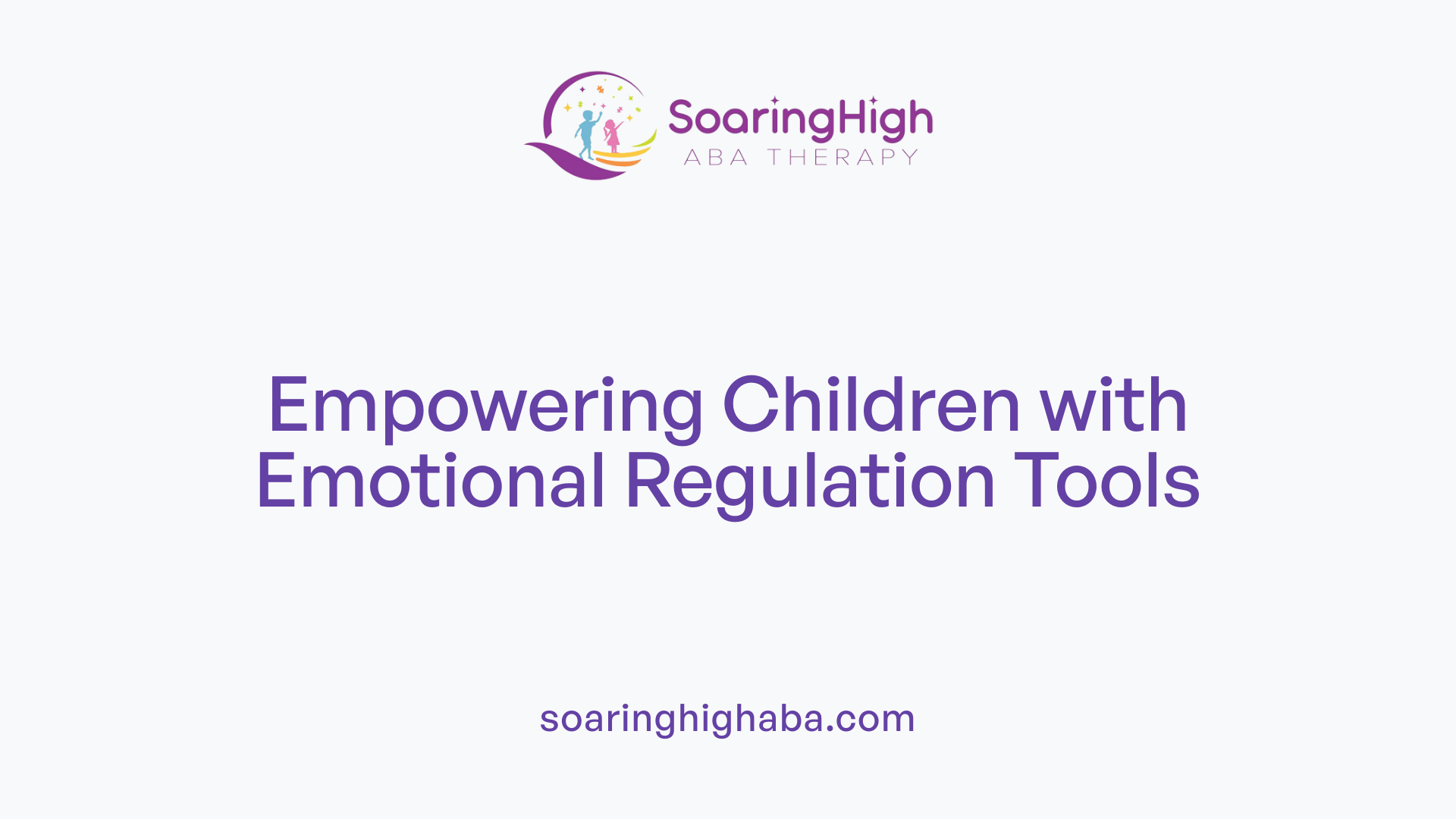Understanding and Addressing Tantrums in Autism
Tantrums in children with autism can be intense and challenging for families and caregivers. These behaviors may arise from various factors such as communication difficulties, sensory overload, or environmental triggers. Applying evidence-based approaches like Applied Behavior Analysis (ABA) can significantly reduce tantrums and improve daily functioning. This article explores how ABA therapy, combined with family participation, can create effective routines that support children in managing their emotions and behaviors.
The Foundations of ABA Therapy for Autism

What are the benefits of ABA therapy in reducing tantrums and improving daily behavior in children with autism?
Applied Behavior Analysis (ABA) is a scientifically validated approach that significantly helps in reducing tantrums and improving daily behaviors in children with autism. This therapy targets environmental influences that trigger challenging behaviors by systematically applying principles of reinforcement and behavior management.
ABA operates by analyzing what occurs before and after a tantrum, allowing therapists and caregivers to understand the function of the behavior. This assessment guides interventions that teach children appropriate ways to express their needs, such as using words or gestures, reducing frustration and harmful reactions.
One of the main strengths of ABA is its focus on skill development. It helps children learn essential skills like communication, social interaction, self-care, and emotional regulation. When children acquire these abilities, the need for tantrums diminishes because they can more effectively express their needs and manage their feelings.
Research shows that early, intensive ABA interventions can lead to dramatic improvements in behavior and developmental progress. These gains enable children to participate more actively in daily routines and social settings, leading to better overall quality of life. The tailored nature of ABA means programs are customized to meet each child's unique needs, promoting independence and supporting them to reach their full potential.
In summary, ABA therapy is a comprehensive approach that reduces problematic behaviors and enhances adaptive skills, providing children with autism the tools to navigate their environment calmly and confidently.
How can ABA therapy be used to reduce tantrums during daily routines for children with autism?
ABA therapy employs several practical strategies to diminish tantrums during everyday activities like dressing, mealtime, or transitions. One core technique is functional communication training, where children are taught to express their needs reliably through methods like picture exchange systems or sign language. This reduces frustration caused by their inability to communicate effectively.
Structured routines are central to ABA practices. Using visual supports such as schedules, visual timers, or countdowns helps children understand what to expect next. This predictability decreases anxiety and the likelihood of tantrums, especially during transitions or unfamiliar activities.
Positive reinforcement plays a vital role. Rewards like praise, stickers, or preferred items are given when children demonstrate appropriate behavior, reinforcing calm and compliant responses. Over time, this encourages children to seek out acceptable ways to fulfill their needs rather than resorting to outbursts.
Additionally, environmental adjustments contribute to better behavior management. Sensory-friendly spaces, calming tools like weighted blankets or noise-canceling headphones, and safe zones help children self-regulate their emotions.
Collaborations with therapists and caregivers ensure individualized plans that address specific triggers for tantrums. These tailored strategies promote emotional regulation and help children manage their feelings better during routine activities.
How does ABA therapy tailor interventions for each child's needs?
ABA therapy begins with comprehensive assessments, including observations and interviews, to understand each child's strengths and challenges. This process helps therapists create personalized treatment plans that target specific behaviors, developmental levels, and environmental factors.
Throughout therapy, continuous data collection and progress monitoring allow for adjustments. As children demonstrate growth, goals are refined to promote further development in communication, social skills, and independence.
Family involvement is essential, as caregivers are trained in ABA techniques like prompting and reinforcement. This training ensures consistency across home and therapy contexts, reinforcing skills and reducing tantrums.
Flexibility in scheduling and open communication between families and professionals allow adaptations to unforeseen changes or disruptions. This dynamic approach ensures that interventions remain relevant and effective, fostering more consistent progress.
| Aspect | Details | Additional Notes |
|---|---|---|
| Assessment | Initial evaluations to determine needs | Includes observations, parent interviews |
| Customization | Developing individualized goals | Tailored to child's strengths |
| Family Training | Educating caregivers | Promotes consistent reinforcement |
| Progress Monitoring | Ongoing data collection | Adjusts strategies as needed |
What strategies does ABA use to reinforce positive behaviors and reduce tantrums?
ABA emphasizes positive reinforcement, which involves rewarding desired behaviors to encourage their recurrence. For example, praising a child for using words instead of screaming can foster verbal communication.
Differential reinforcement is also utilized, where behaviors incompatible with tantrums, such as calm speaking or waiting patiently, are reinforced. This increases the likelihood that children will choose these appropriate behaviors.
Ignoring tantrums or responding minimally is another important strategy, teaching children that tantrums will not result in desired outcomes. Instead, calm and appropriate behaviors are consistently rewarded.
Teaching coping skills is part of the intervention, including deep breathing, sensory tools like fidget toys, and calming routines that help children self-regulate.
How is ABA integrated into daily routines and environments?
Incorporating ABA principles into daily routines involves establishing predictable schedules and visual supports. For instance, visual timers before transitions prepare children for changes, reducing surprises that can trigger tantrums.
Therapists and caregivers work together to embed communication training, social skills, and self-help skills like dressing or brushing teeth into everyday activities.
Maintaining a consistent environment with minimal distractions and providing frequent breaks during demanding tasks help children maintain focus and avoid frustration.
This seamless integration helps generalize skills across settings, making daily life more manageable and less stressful for children with autism.
How do family and caregiver participation enhance ABA therapy outcomes?
Family involvement is crucial in maximizing the benefits of ABA therapy. Training caregivers in reinforcement techniques, prompting, and behavior management ensures consistency across settings.
Active collaboration allows for ongoing feedback, helping therapists adjust interventions based on real-life observations and challenges.
Engaging in therapy activities at home, such as practicing communication skills or implementing visual supports, promotes skill generalization and reduces tantrums.
Planning for scheduling disruptions and balancing therapy with daily family routines ensures sustained progress and reduces stress.
In conclusion, effective management of tantrums in children with autism through ABA combines tailored interventions, environmental supports, caregiver training, and ongoing collaboration, ultimately fostering a supportive environment for growth and development.
Identifying Triggers and Underlying Causes of Tantrums

What behavioral triggers lead to tantrums in children with autism?
Children with autism may experience tantrums due to various triggers rooted in their sensory processing, communication skills, and emotional regulation capabilities. Common behavioral triggers include frustrations when unable to express needs or desires, sensory overload from noisy environments or bright lights, and seeking attention from caregivers. Additionally, some children may have a desire for control over events or activities, and when their preferences are disregarded or routines disrupted, tantrums can result. Tantrums can also serve as an escape from demanding tasks or situations that overwhelm or bore them.
Understanding these triggers is essential for developing effective management strategies. By observing specific behaviors and outcomes, caregivers and therapists can identify whether a tantrum stems from frustration, sensory overload, or other causes.
Environmental and Routine Adjustments to Prevent Tantrums
What strategies and techniques within ABA therapy can help manage and prevent tantrums during daily activities?
ABA therapy uses a variety of approaches to help children with autism manage and avoid tantrums in everyday situations. One of the foundational methods is conducting a functional behavior assessment (FBA), which helps identify specific triggers like sensory overload, communication issues, or environmental frustrations.
To reduce these triggers, modifying the environment is crucial. This can involve brightening or calming sensory inputs, removing unnecessary distractions, and creating a predictable setup. Strategies like offering choices empower children, giving them control over their activities, which reduces frustration. Using visual schedules with pictures and timers helps children understand what will happen next and prepares them for transitions.
Providing transition warnings with visual timers allows children to anticipatively prepare for changes, reducing anxiety and oppositional behaviors. Teaching alternative communication methods—such as picture exchanges, sign language, or apps—gives children tools to express their needs without resorting to tantrums.
Positive reinforcement, such as praise or tangible rewards, strengthens desirable behaviors and builds confidence. Additionally, planning small, manageable steps within activities increases success and decreases frustration. When tantrums do occur, calming techniques like sensory tools, space to cool down, and clear prompts help de-escalate the situation quickly.
Overall, these strategies create a predictable, supportive environment that fosters calm, cooperative behavior, and minimizes triggers for tantrums.
Effective Communication and Visual Supports

How can ABA therapy be used to reduce tantrums during daily routines for children with autism?
ABA therapy plays a crucial role in helping children with autism manage their emotions and behaviors during daily routines. One of its primary methods is functional communication training, which teaches children appropriate ways to express their needs. For example, using picture exchange systems or sign language allows children to communicate without resorting to tantrums.
Establishing structured routines supported by visual aids like schedules and timers is another effective strategy. Visual schedules help children understand what to expect next, reducing anxiety and confusion that often trigger outbursts. Timers can signal transition periods, giving children a clear indication of impending changes.
Consistent use of positive reinforcement encourages children to engage in desirable behaviors, such as asking for a break or expressing needs calmly. Rewards like praise, stickers, or preferred activities motivate children to repeat these behaviors.
Creating sensory-friendly environments, with calming tools and designated safe spaces, helps children regulate overwhelming feelings that might otherwise lead to tantrums. For example, providing sensory toys or calming music can diffuse distress.
Importantly, collaboration with professionals enables the development of individualized strategies addressing each child’s specific triggers. These tailored approaches foster emotional regulation and reduce the likelihood of tantrums during routine activities.
How can ABA techniques be integrated into daily routines to manage and reduce tantrums?
Integrating ABA techniques into daily routines involves establishing predictable patterns using visual supports. Picture charts, visual schedules, and timers help children understand the sequence of activities, which builds a sense of security and predictability.
Reinforcement of positive behaviors should occur immediately during routines such as mealtime, play, or chores. Rewards like verbal praise or token systems motivate children to participate cooperatively, decreasing frustration.
Teaching functional communication skills during these routines empowers children to express their needs appropriately. For example, prompting a child to use words or gestures when they want a toy reduces the likelihood of tantrums caused by frustration.
Offering choices within routines, such as selecting a toy or song, promotes independence and a sense of control, which can lower challenging behaviors.
It's essential to keep an ongoing partnership with ABA professionals and caregivers. Regular monitoring and adjusting strategies ensure the routines remain effective and tailored to the child's evolving needs.
Use of visual schedules and social stories
Visual supports like schedules and social stories are foundational tools in ABA for children with autism. They help clarify expectations and prepare children for upcoming events. Social stories explain social rules and appropriate behaviors in simple terms, making social interactions more understandable.
Teaching functional communication skills
Skills such as requesting, labeling objects, or commenting are taught gradually through modeling, prompting, and reinforcement. Visual aids like picture cards or electronic devices support this learning process.
Importance of clear instructions and warnings
Providing straightforward, direct instructions minimizes confusion. Giving warnings before transitions, using visual cues or timers, allows children to prepare mentally, which reduces anxiety and outbursts. Combining these methods makes routines smoother and tantrum-free.
Summary Table | Strategy | Description | Benefits | Example| | --- | --- | --- | --- | | Visual Schedules | Daily routines displayed visually | Decreases anxiety, promotes independence | Using picture charts for morning routines | | Reinforcement | Reward desirable behaviors immediately | Encourages positive compliance | Praising when a child requests calmly | | Function Communication | Teaching children to express needs | Reduces frustration and tantrums | Using sign language during snack time | | Clear Instructions | Simple, direct commands | Less confusion and resistance |
Teaching Coping Skills and Emotional Regulation

What strategies and techniques within ABA therapy can help manage and prevent tantrums during daily activities?
ABA therapy offers a range of approaches to help children with autism handle and decrease tantrums during everyday routines. First, it often starts with assessing what triggers challenging behaviors through a Functional Behavior Assessment (FBA). This helps identify if a child becomes overwhelmed by sensory input, struggles with communication, or desires control.
Based on this, therapists and caregivers can modify the environment—such as offering choices between activities or visual schedules—so the child feels more in control and understands what to expect. Transition warnings, like visual timers or countdowns, prepare the child for upcoming changes, preventing surprises that might trigger a tantrum.
Teaching alternative ways to communicate is crucial. Techniques such as picture exchange communication systems (PECS) or sign language help children express their needs instead of resorting to tantrums. When the child successfully uses these skills, positive reinforcement like praise or small rewards encourages them to keep using appropriate behaviors.
Proactively, ensuring the environment is organized with fewer distractions and scheduling regular, short breaks during demanding tasks can keep frustration levels low. If a tantrum does occur, quick interventions such as sensory tools (like stress balls or weighted blankets) and clear, calm prompts can help de-escalate the situation.
All these strategies combine environmental modifications, teaching communication, and immediate calming techniques to create a supportive structure that reduces the likelihood of tantrums and promotes emotional regulation.
How can ABA techniques be integrated into daily routines to manage and reduce tantrums?
Integrating ABA strategies into daily routines helps children develop skills and reduces tantrum frequency. Establishing a predictable schedule—using visual supports like picture schedules, clock visuals, and timers—gives children clear expectations and reduces anxiety associated with transitions.
Reinforcing positive behaviors immediately is essential. For example, when a child uses appropriate communication or follows a routine, they should be praised or given a desired item or activity to foster continued cooperation.
Teaching functional communication skills is woven into everyday routines. During meals, dressing, or chores, caregivers model and prompt children to use words or gestures to express their needs, lessening frustration that can provoke disruptive behaviors.
Offering opportunities for choices—like selecting a toy or snack—enhances the child's sense of control and independence, which can decrease demand avoidance behaviors.
Consistent collaboration with trained ABA providers ensures that routines are adjusted based on the child's progress. Caregivers are encouraged to participate in training sessions, learning how to prompt, reinforce, and appropriately respond to behaviors.
In doing so, routines become structured yet flexible frameworks that support the child's emotional needs, promote skill development, and prevent tantrums.
Deep breathing exercises and calming routines
Implementing physiologically calming activities like deep breathing exercises helps children learn self-regulation. Guided through simple steps—such as slow inhalations through the nose followed by controlled exhalations—children can manage their arousal levels.
Calming routines might include sensory activities like listening to soothing music, using weighted blankets, or engaging with sensory bins. These activities alleviate sensory overload and promote a sense of security.
Sensory tools and regulation techniques
Sensory regulation tools such as chewable jewelry, fuzzy fidget toys, or calming lights provide sensory input that can help children self-soothe and reduce anxiety.
Strategies like creating a designated calm-down area with comforting items and visual supports can provide a refuge during moments of distress.
Fostering independence and self-control
Teaching children to recognize signs of overwhelm and use calming strategies fosters independence. Skills like requesting a break or using a visual timer to manage frustration empower children to take control over their emotions.
Visual cues, timers, and scheduled breaks help children understand when they can pause and reset, leading to fewer tantrums and increased self-reliance.
| Technique | Purpose | Implementation Example |
|---|---|---|
| Visual Schedule | Reduce anxiety by clarifying daily routines | Use picture charts for activities like meal, play, and sleep time |
| Reinforcement | Encourage desired behaviors | Praise or reward when the child communicates needs appropriately |
| Choice-Making | Promote independence and reduce frustration | Offer two preferred items during transitions |
| Sensory Tools | Provide self-regulation options | Use stress balls or weighted blankets during rest periods |
| Structured Breaks | Prevent overload and tantrums | Schedule short, frequent breaks during challenging tasks |
By applying these strategies consistently, children with autism can develop better coping skills, minimize emotional outbursts, and thrive in daily routines.
The Role of the Family in ABA Implementation

How can families and caregivers effectively implement ABA strategies during daily routines?
Families and caregivers are vital in applying ABA strategies, and a consistent approach across settings maximizes the child's progress. Establishing predictable routines helps children know what to expect, reducing anxiety and potential tantrums. Incorporating learning into daily activities like mealtime, dressing, or play allows children to practice skills in natural contexts.
Positive reinforcement—such as praise, tokens, or preferred items—encourages children to repeat desirable behaviors. Breaking complex tasks into small, manageable steps makes learning less overwhelming and boosts children’s confidence. When parents and caregivers collaborate with ABA professionals, they receive tailored guidance and feedback, ensuring strategies fit the child's needs.
Creating an organized environment with visual supports like schedules, picture cues, or timers helps children understand expectations. Clear instructions and consistent routines reduce confusion and behavioral issues. Furthermore, caregivers should practice skills regularly in diverse settings to promote generalization.
Ongoing training from ABA specialists equips families with the necessary techniques, such as prompting and reinforcement. Data collection during daily activities allows for tracking progress and making timely adjustments. Overall, active parental involvement and the integration of ABA principles into everyday routines create a supportive environment that fosters skill development and behavioral improvements.
Addressing scheduling hurdles involves planning for disruptions and ensuring consistency, which is vital for success in reducing tantrums.
Scheduling challenges are common, but careful planning helps maintain therapy consistency. Families should anticipate potential disruptions, such as appointments or family obligations, and develop flexible routines that can be adapted without losing structure.
Open communication with therapists is crucial; sharing any changes or obstacles allows for timely adjustments to intervention plans. Flexibility doesn't mean abandoning routines but rather modifying them to fit the current circumstances. For instance, if a planned session must be canceled, families can incorporate similar reinforcement or learning activities during other parts of the day.
Balancing therapy schedules with family life can be complex, but prioritizing consistency supports the child's emotional stability and progress. Regular check-ins with therapists help monitor effectiveness and refine strategies.
This proactive approach minimizes frustration and helps children transition smoothly between activities, reducing the likelihood of tantrums. Clear expectations, transparency, and adaptive planning are essential components of effectively managing scheduling hurdles and providing ongoing support.
Monitoring Progress and Adjusting the Approach
Why is continuous collaboration between therapists and families important for personalizing ABA therapy?
Active collaboration between therapists and families plays a vital role in tailoring ABA therapy to fit each child's unique needs. By frequently sharing observations and feedback, both parties can identify what strategies are working well and which areas require more focus. This ongoing dialogue creates a dynamic treatment plan that adapts as the child's skills and behaviors evolve.
Regular communication builds trust and ensures that interventions stay relevant and effective. It also encourages families to be actively involved in reinforcement and routine management outside therapy sessions, promoting consistency across settings. When parents and caregivers understand the goals and methods, they can better support their child's growth at home.
Monitoring progress through data collection is essential. Collecting objective data helps identify patterns and measure improvements over time. When combined with parental insights, data guides necessary adjustments, optimizing therapy outcomes.
Adapting interventions based on the child's response ensures that the treatment remains effective and engaging. If certain techniques no longer produce desired results, therapists can modify their approach or introduce new strategies. This flexibility enhances the child's learning experience and reduces frustration, including tantrums.
How do therapists and families work together to modify ABA strategies?
Therapists use progress data to determine whether goals are being met or if modifications are needed. For example, if a child's communication skills improve but tantrums persist during transitions, the plan can be adjusted to include more visual supports or sensory tools.
Parents are trained to implement specific techniques, such as providing choices during routines or applying visual timers, which help the child anticipate changes and reduce anxiety. Through regular meetings and feedback sessions, both parties discuss progress, challenges, and next steps.
This collaborative process often involves sharing success stories and addressing setbacks collectively. When families feel empowered and informed, they are more likely to consistently apply strategies at home, reinforcing learning in everyday life.
How does ongoing collaboration impact long-term success?
Consistent teamwork ensures the therapy remains tailored to the child's developing needs. It also allows for timely adjustments, preventing stagnation or setbacks.
Research shows that early and continuous intervention, supported by strong family involvement, leads to better developmental outcomes, including reduced tantrums and increased independence.
In summary, the integration of regular progress monitoring and active family participation creates a responsive framework. It enables therapists and caregivers to refine strategies, celebrate successes, and address challenges promptly, thereby supporting sustainable growth and improved quality of life for children with autism.
Concluding Summary and the Path Forward
Why is early intervention critical and how does it influence the success of ABA therapy?
Early intervention plays a vital role in the development of children with autism because it targets crucial periods when the brain is most adaptable to learning new skills. Initiating ABA therapy during these formative years can lead to substantial improvements in communication, social skills, and behavior management. When therapy begins early, children are more likely to develop foundational skills that support independence and emotional regulation later in life.
The benefits of early intervention extend beyond skill acquisition. It significantly reduces the severity and frequency of challenging behaviors, including tantrums, by addressing the root causes and environmental triggers early on. This proactive approach promotes smoother development and helps children integrate more comfortably into social and daily routines.
The success of ABA therapy is closely linked to the collaboration between professionals and families. Family involvement ensures consistency in strategies applied across different settings, reinforcing learning and positive behaviors. When parents and caregivers are trained and actively participate, children experience a seamless continuation of therapy techniques at home, which enhances overall progress.
Furthermore, continuous review and customization of routines are essential. By regularly assessing a child's progress and adjusting strategies accordingly, therapists and families can address the evolving needs of the child. Personalized routines that consider individual preferences and developmental stages foster better engagement and skill retention.
In summary, early intervention supported by tailored ABA strategies and active family participation maximizes developmental gains. This comprehensive approach helps children with autism develop essential skills, reduces tantrums, and improves their overall quality of life, setting a strong foundation for future growth and independence.
Moving Forward with Support and Consistency
Implementing ABA strategies during daily routines significantly helps in reducing tantrums and fostering positive behaviors in children with autism. Through individualized assessment, environmental adjustments, visual supports, and active family participation, children develop essential skills and emotional regulation. Continuous collaboration with professionals ensures that interventions remain effective and adaptable to the child's evolving needs. Early intervention maximizes developmental gains and promotes independence, ultimately improving quality of life for children and reducing stress for families. Moving forward, consistent application, ongoing training, and flexible planning are vital in creating a nurturing environment where children can thrive and reach their full potential.
References
- Tips For Managing Tantrums for Your Child With Autism
- Mastering Home-Based ABA Therapy Scheduling Strategies
- How to Deal with Tantrums in ABA Therapy
- Benefits of ABA Therapy for Children with Autism
- Applied Behavior Analysis (ABA)
- The Top 10 Reasons Children With Autism Deserve ABA
- Applied Behavior Analysis (ABA)





































































































